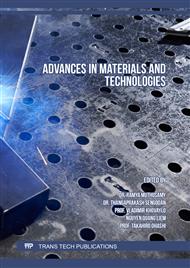p.75
p.81
p.87
p.95
p.103
p.111
p.119
p.129
p.139
Casting of Wire Using Twin Wheel Caster with Melt Holding Nozzle
Abstract:
A twin-wheel caster with a hole nozzle was developed to cast thin aluminum alloy wire. The lower large wheel had a trapezoid groove with a cross-sectional area of 22.5 mm2, and the upper small wheel was flat. Molten-metal flow onto the wheel was controlled by the gap between the wheel and the nozzle, and the ejection angle of the molten metal. When the gap was not appropriate, bulges formed on the free solidified surface of the molten metal on the wheel. The bulges were flattened by setting the gap to the correct size of 3 to 4 mm. The appropriate angle was found to be 60°. A thin wire of 6061 aluminum alloy could be cast continuously at a speed of 5 m/min. The cross-sectional area of the nozzle hole was 3 mm2. The cross-sectional area of the as-cast wire was 42.7 mm2.
Info:
Periodical:
Pages:
103-108
Citation:
Online since:
November 2022
Authors:
Keywords:
Price:
Сopyright:
© 2022 Trans Tech Publications Ltd. All Rights Reserved
Share:
Citation:



